The Drake is being very kind to us today. It actually calmed quite a bit last night, and with only 4-5 foot waves, we’re cutting right through it at 10.6 kn. With this kind of seas, the planktoneers are able to drop the nets every 4 hours as scheduled, and much to Rudi Scheltema’s delight.
Not so much to Rudi’s delight, however, is the fact that the nets have not been yielding much plankton out here. “Why not?” one might ask. And so I did. Of course, no one knows for sure, but Rudi had already written some thoughts on the subject when I asked him.
Comments on larval distribution, gene flow and Antarctic fronts:
1) Reproduction in many species is periodic
2) The Polar Front varies temporally in position and configuration
3) If larvae are not found in a sample, we may not be in the right place at the right time
4) It may take very few larvae to maintain genetic continuity, and intermittent gene flow could be reflected in the occurrence of larvae at various points in the Drake Passage.
The plankton schedule has kicked up a notch to every 15 miles. It’s a very busy schedule and the teams are on 12 hour shifts. These two days will be hard, but productive for the final data for this cruise.
Max Nikurashin also continues producing plotting printouts for XBTs, CTDs, current flow, and ADCPs. We hope to tie that all together as we steam the Straits of Magellan.
Gigantism
During our cruise one major activity has been collecting invertebrate animals that live on the bottom of the waters of the Southern Ocean. In the first several bottom samples taken, we discovered that the benthic (bottom-dwelling) community can vary greatly from place to place, or at different depths. We typically find brittle stars, soft corals, and sponges. These are mixed in with many seastars, isopods (pill-bugs), snails, and other animals. The Antarctic region is well known for gigantism. That is, some species are much larger in the Antarctic than their closely-related counterparts in warmer coastal waters. Pycnogonids, or "sea spiders", are one such example. Typically a couple of centimeters (1 inch) or less in size, these animals grow up to 25 times that size in the Antarctic (see photos at right).
You can image the eeeyyewww!’s when we found a slimy ribbon worm, typically 0.5-1 cm (less than ½ inch) thick, but here, as big as a snake (no photo, you’d never be able to take it). The photo below the spider shows a polychaete or “sea mouse” that is usually only up to two inches long (see photos at right).
Scientists are not certain why so many animals get so big in the Antarctic. It may be the high seasonal availability of nutrients or the up-welling of nutrients from deeper waters. However, one other habitat that often exhibits gigantism is the deep sea, and the most obvious common factor that the both habitats share is cold water…very cold water.
And my personal theory with first hand experience for cause of Gigantism in the Antarctic… (see 3rd set of photos at right).
Back to the Science
After Dinner Talks: 4 speakers from the science crew, describing their main courses of study
Rebecca Hunter
Studies Astrotoma (a type of brittle star), it’s distribution in Antarctic waters, and how those found at different sites are related to each other (this will be done via DNA analysis at home). In 2004, the distribution between S. American and Antarctic waters was about 50:50. This time they were abundant in Argentine waters, and rare in the Southern Ocean.
Max Nikurashin
XBT, CTD and ADCP Max plotted all of the XBT drops done in various locations on this cruise. He explained what knowing the temperature of the water at various depths over regular intervals tells us about the properties and dynamics of the ocean in this region.
Jennifer Putland
Krill life cycle study tells us that the juvenile stage takes place during the winter. Jen is studying the ecology of krill in the Antarctic, and has had the opportunity to do her own set of net tows to gather krill. She has frozen these specimens and will analyze them back in Florida for protein and lipid content.
Jonathan Craft
Studies Halocaridina rubra shrimp, which only live in Hawaii (and you might have seen them living in ecospheres). They live in an anchialine habitat, or a pond with a subterranean connection to the open sea. These habitats are being destroyed by land development, and Jon is studying the effects of this change on this, Hawaii’s most predominant anchialine fauna.
Don't hesitate to email
questions to us at outreach@lmg.usap.gov
|
|
Longitude/Latitude:
S58° 38.592’ W63° 49.356’
Temperature:
Wind: SSW 16-18kn
Air Temp: -0.8°C
Wind Chill: -14.9°C
Surface Water Temp: 1.475°C
Menu:
Spaghetti, meat ravioli, Brussels sprouts, rice, salad, soup; Lamb chops, scrod, Brussels sprouts, penciltip rice, salad, ice cream, strawberry pie and cookies.
Photos:

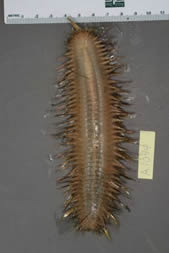
Top: Antarctic pycnogonid or “sea spider”
Bottom: Antarctic polychaete or “sea mouse”

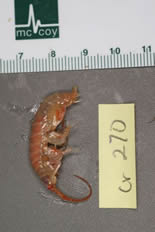
Top: Isopod
Bottom: Amphipod (‘pill bug’ size is normal)

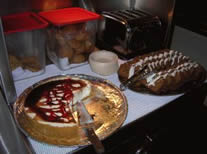
Top: Breakfast of Champions Bottom: Desserts of future diabetics.
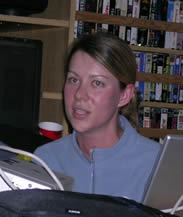
Rebecca Hunter

Max Nikurashin
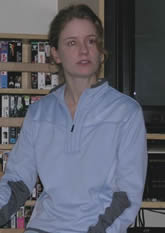
Jennifer Putland
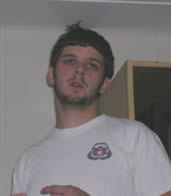
Jonathan Craft
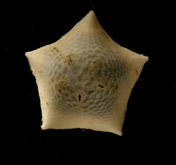
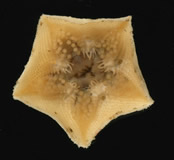
Tiny White Sea Star (dorsal and ventral)
[Microscope Photos by Susie Balser]
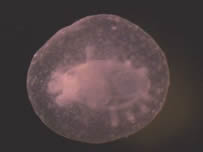
Future sea cucumber (might be gigantic some day?). [Microscope Photo by Alex Eaves]
|














